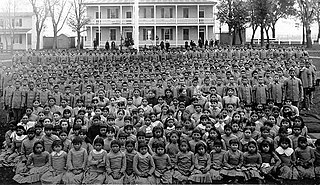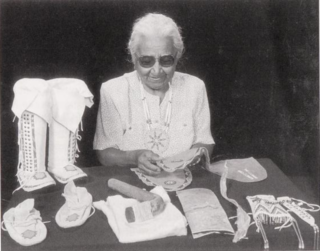
Caddo County is a county located in the U.S. state of Oklahoma. As of the 2020 census, the population was 26,945. Its county seat is Anadarko. Created in 1901 as part of Oklahoma Territory, the county is named for the Caddo tribe who were settled here on a reservation in the 1870s. Caddo County is immediately west of the seven-county Greater Oklahoma City metro area, and although is not officially in the metro area, it has many economic ties in this region.

Anadarko is a city and county seat of Caddo County, Oklahoma, United States. The city is fifty miles (80.5 km) southwest of Oklahoma City. The population was 5,745 at the 2020 census.
The American Indian Exposition, held annually during the first full week in August at the Caddo County Fairgrounds in Anadarko, Oklahoma, is one of the oldest and largest intertribal gatherings in the United States. Sponsored by fifteen tribes, representatives from up to fifty other tribes participate in any given year.
The Indian City USA Cultural Center, formerly known as Indian City USA, was an outdoor museum in Anadarko, Oklahoma.

The Kichai tribe was a Native American Southern Plains tribe that lived in Texas, Louisiana, and Oklahoma. Their name for themselves was K'itaish.
Sequoyah High School is a Native American boarding school serving students in grades 7 through 12, who are members of a federally recognized Native American tribe. The school is located in Park Hill, Oklahoma, with a Tahlequah post office address, and is a Bureau of Indian Education (BIE) grant school operated by the Cherokee Nation.

Sherman Indian High School (SIHS) is an off-reservation boarding high school for Native Americans. Originally opened in 1892 as the Perris Indian School, in Perris, California, the school was relocated to Riverside, California, in 1903, under the name Sherman Institute. When the school was accredited by the Western Association of Schools and Colleges in 1971, it became known as Sherman Indian High School.

American Indian boarding schools, also known more recently as American Indian residential schools, were established in the United States from the mid-17th to the early 20th centuries with a primary objective of "civilizing" or assimilating Native American children and youth into Anglo-American culture. In the process, these schools denigrated Native American culture and made children give up their languages and religion. At the same time the schools provided a basic Western education. These boarding schools were first established by Christian missionaries of various denominations. The missionaries were often approved by the federal government to start both missions and schools on reservations, especially in the lightly populated areas of the West. In the late 19th and early 20th centuries especially, the government paid religious orders to provide basic education to Native American children on reservations, and later established its own schools on reservations. The Bureau of Indian Affairs (BIA) also founded additional off-reservation boarding schools based on the assimilation model. These sometimes drew children from a variety of tribes. In addition, religious orders established off-reservation schools.

Chilocco Indian School was an agricultural school for Native Americans on reserved land in north-central Oklahoma from 1884 to 1980. It was approximately 20 miles north of Ponca City, Oklahoma and seven miles north of Newkirk, Oklahoma, near the Kansas border. The name "Chilocco" is apparently derived from the Creek tci lako, which literally meant "big deer" but typically referred to a horse.
The Nadaco, also commonly known as the Anduico, are a Native American tribe from eastern Texas. Their name, Nadá-kuh, means "bumblebee place."

The Bureau of Indian Education (BIE), headquartered in the Main Interior Building in Washington, D.C., and formerly known as the Office of Indian Education Programs (OIEP), is a division of the U.S. Department of the Interior under the Assistant Secretary for Indian Affairs. It is responsible for the line direction and management of all BIE education functions, including the formation of policies and procedures, the supervision of all program activities, and the approval of the expenditure of funds appropriated for BIE education functions.
Concho Indian Boarding School was a boarding school for members of the Cheyenne and Arapaho Tribes. It initially served grades 1–6, and later extended classes through grade 8. Admission was later opened to other Native American students.
Sherman Terrance Chaddlesone was a Kiowa Indian painter from Anadarko, Oklahoma, who played a pivotal role in late 20th century Native American art.

Susie Peters was an American preservationist and matron at the Anadarko Agency, who worked to promote Kiowa artists. Born to white parents in Tennessee, she moved to Indian Territory with her family prior to Oklahoma becoming a state. While working as a matron for the Indian Agency, she discovered the talent of the young artists who would become known as the Kiowa Six and introduced them to Oscar Jacobson, director of the University of Oklahoma's art department. She was honored by the National Hall of Fame for Famous American Indians and both adopted by the tribe and given a Kiowa name in 1954. In 1963, the Anadarko Philomathic Club created an annual art award in her name. She was inducted into the Oklahoma Women's Hall of Fame in its inaugural year, 1982.

Josephine Myers-Wapp was a Comanche weaver and educator. After completing her education at the Haskell Institute, she attended Santa Fe Indian School, studying weaving, dancing, and cultural arts. After her training, she taught arts and crafts at Chilocco Indian School before joining the faculty of the newly opened Institute of American Indian Arts in Santa Fe. She taught weaving, design, and dance at the institute, and in 1968 was one of the coordinators for a dance exhibit at the Mexican Summer Olympic Games. In 1973, she retired from teaching to focus on her own work, exhibiting throughout the Americas and in Europe and the Middle East. She has work in the permanent collection of the IAIA and has been featured at the Smithsonian Institution. Between 2014 and 2016, she was featured in an exhibition of Native American women artists at the Museum of Indian Arts and Culture in Santa Fe.

Southern Plains Indian Museum is a Native American museum located in Anadarko, Oklahoma. It was opened in 1948 under a cooperative governing effort by the United States Department of the Interior and the Oklahoma state government. The museum features cultural and artistic works from Oklahoma tribal peoples of the Southern Plains region, including the Caddo, Chiricahua Apache, Comanche, Delaware Nation, Kiowa, Plains Apache, Southern Arapaho, Southern Cheyenne, and Wichita.

Alice Littleman was a Kiowa beadwork artist and regalia maker, who during her lifetime was recognized as one of the leading Kiowa beaders and buckskin dressmakers. Her works are included in the permanent collections of the National Museum of Natural History, the National Museum of the American Indian, the Southern Plains Indian Museum, and the Oklahoma Historical Society.
Flandreau Indian School (FIS), previously Flandreau Indian Vocational High School, is a boarding school for Native American children in unincorporated Moody County, South Dakota, adjacent to Flandreau. It is operated by the Bureau of Indian Education (BIE) and is off-reservation.
Pierre Indian Learning Center (PILC), also known as Pierre Indian School Learning Center, is a grade 1-8 tribal boarding school in Pierre, South Dakota. It is affiliated with the Bureau of Indian Education (BIE).












